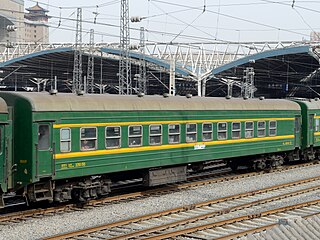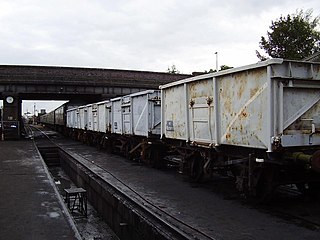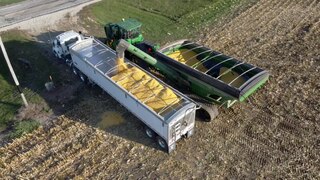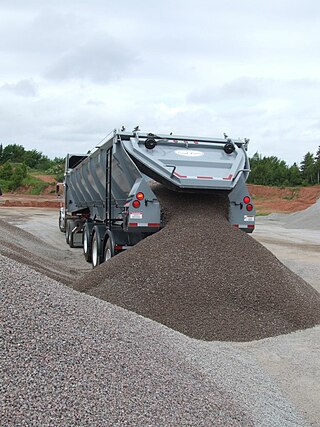
A railroad car, railcar, railway wagon, railway carriage, railway truck, railwagon, railcarriage or railtruck, also called a train car, train wagon, train carriage or train truck, is a vehicle used for the carrying of cargo or passengers on a rail transport network. Such cars, when coupled together and hauled by one or more locomotives, form a train. Alternatively, some passenger cars are self-propelled in which case they may be either single railcars or make up multiple units.

A dump truck, known also as a dumping truck, dump trailer, dumper trailer, dump lorry or dumper lorry or a dumper for short, is used for transporting materials for construction as well as coal. A typical dump truck is equipped with an open-box bed, which is hinged at the rear and equipped with hydraulic rams to lift the front, allowing the material in the bed to be deposited ("dumped") on the ground behind the truck at the site of delivery. In the UK, Australia, South Africa and India the term applies to off-road construction plants only and the road vehicle is known as a tip lorry, tipper lorry, tipper truck, tip truck, tip trailer or tipper trailer or simply a tipper.

A hopper car (US) or hopper wagon (UIC) is a type of railroad freight car used to transport loose bulk commodities such as coal, ore, grain, and track ballast. Two main types of hopper car exist: covered hopper cars, which are equipped with a roof, and open hopper cars, which do not have a roof.

In North American railroad terminology, a gondola is an open-topped rail vehicle used for transporting loose bulk materials. Because of their low side walls, gondolas are also suitable for the carriage of such high-density cargos as steel plates or coils, or of bulky items such as prefabricated sections of rail track. Gondolas are distinct from hopper cars in that they do not have doors on their floor to empty cargo.

A covered hopper is a self-clearing, enclosed, weatherproof railroad freight car. It has a fixed roof, sides, and ends with openings for loading through the top and unloading through the bottom. Covered hopper cars are designed for carrying dry bulk loads, such as grain, sand, clay and Portland cement.

A rotary car dumper or wagon tippler (UK) is a mechanism used for unloading certain railroad cars such as hopper cars, gondolas or mine cars. It holds the rail car to a section of track and then rotates the track and car together to dump out the contents. Used with gondola cars, it is making open hopper cars obsolete. Because hopper cars require sloped chutes in order to direct the contents to the bottom dump doors (hatches) for unloading, gondola cars allow cars to be lower, thus lowering their center of gravity, while carrying the same gross rail load. Cars are equipped with rotary couplers to allow dumping them while they are still coupled; a "Double Rotary" gondola or hopper has rotary couplers on both ends to allow it to be unloaded while it remains coupled to stationary cars at each end.

A silo is a structure for storing bulk materials. Silos are used in agriculture to store fermented feed known as silage, not to be confused with a grain bin, which is used to store grains. Silos are commonly used for bulk storage of grain, coal, cement, carbon black, woodchips, food products and sawdust. Three types of silos are in widespread use today: tower silos, bunker silos, and bag silos.

A mineral wagon or coal truck is a small open-topped railway goods wagon used in the United Kingdom and elsewhere to carry coal, ores and other mine products.

A hopper barge is a type of barge commonly designed to transport commodities like coal, steel, rocks, sand, soil and waste. 'Hopper barge' can also refer to a barge that dumps cargo at sea. These are now commonly called 'split hopper barge', because they split along the length of the hull. Split hopper barges can be non-propelled or self-propelled.

A semi-trailer is a trailer without a front axle. The combination of a semi-trailer and a tractor truck is called a semi-trailer truck.

A chaser bin, also called grain cart, bank out wagon or (grain) auger wagon, is a trailer towed by a tractor with a built-in auger conveyor system, usually with a large capacity.

A live bottom trailer is a semi-trailer used for hauling loose material such as asphalt, grain, potatoes, sand and gravel. A live bottom trailer is the alternative to a dump truck or an end dump trailer. The typical live bottom trailer has a conveyor belt on the bottom of the trailer tub that pushes the material out of the back of the trailer at a controlled pace. Unlike the conventional dump truck, the tub does not have to be raised to deposit the materials.

A mixer-wagon, or diet feeder, is a specialist agricultural machine used for accurately weighing, mixing and distributing total mixed ration (TMR) for ruminant farm animals, in particular cattle and most commonly, dairy cattle.
A specialized set of jargon describe the tools, equipment, and employment sectors used in the trucking industry in the United States. Some terms may be used within other English-speaking countries, or within the freight industry in general. For example, shore power is a term borrowed from shipping terminology, in which electrical power is transferred from shore to ship, instead of the ship relying upon idling its engines. Drawing power from land lines is more efficient than engine idling and eliminates localized air pollution. Another borrowed term is "landing gear", which refers to the legs which support the front end of a semi-trailer when it is not connected to a semi-truck. Some nicknames are obvious wordplay, such as "portable parking lot", in reference to a truck that carries automobiles.

A sliding door is a type of door that is mounted on or suspended from a track for the door to slide, usually horizontally and outside. It is a feature predominantly found in minibuses, buses, and vans, so as to allow a large unobstructed access to the interior for loading and unloading of passengers or cargo without the doors interfering with adjacent space.

Open wagons form a large group of railway goods wagons designed primarily for the transportation of bulk goods that are not moisture-retentive and can usually be tipped, dumped or shovelled. The International Union of Railways (UIC) distinguishes between ordinary wagons and special wagons (F/6). Open wagons often form a significant part of a railway company's goods wagon fleet; for example, forming just under 40% of the Deutsche Bahn's total goods wagon stock in Germany.
The International Union of Railways groups all special classes of railway goods wagon into Class U in its goods wagon classification system.
The Victorian Railways in Australia have had a vast range of hopper-type wagons over the last century, for transporting anything from grains through fuel to various powders.
The wagon with opening roof is a type of railway goods wagon that is, nowadays, defined and standardised by the International Union of Railways (UIC) as Class "T". They are a large category of rail vehicle, predominantly used for the transport of hygroscopic bulk commodities such as cement, plaster, lime, potash and grain.

A grain hopper trailer is a trailer pulled by a semi tractor and used to haul bulk commodity products, such as grain. These trailers are used extensively throughout the United States to transport agricultural products as well as any other commodity that can be hauled in bulk and loaded and unloaded through the trailer.


















